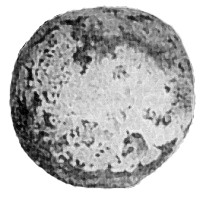
The chalk ball found near Laon

The chalk ball found near Laon
Maximilien Melleville, the Vice President of the Société Academique de Laon (France) and author of Dictionnaire historique du département de l’Aisne (1857), reported the discovery of a chalk ball from an early Eocene lignite bed and a translation of his report appeared in The Geologist of April 1862. The conventional date for these beds is 45 to 55 million years old. He was in no doubt that the ball was genuine, as it had been stained a black colour by contact with the lignite, apart from a small circle at the top of the object, where it had protruded through into a shyly deposit above, which retained the pale yellow of natural chalk.
This discovery seems perfectly genuine, but it is unclear why anyone believed that the ball must have been the product of human manufacture. Moreover, the published photograph does not give any confidence in Melleville’s description, showing instead a roughly spherical object with unevenly stained surfaces. Melleville provided no evidence for the object having been carved, but gave the game away in his quoted statement that “as extraordinary as it might seem to those attached to standard evolutionary views, the evidence associated in this find suggest that if humans made the ball, they must have been in France 45 - 55 million years ago.” Melleville would appear from this to have been an early opponent of Darwin’s then new theory of evolution by natural selection (On the Origin of Species had been published in 1859).
This page was last updated on 1 March 2008
Written by Keith Fitzpatrick-Matthews